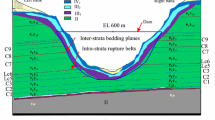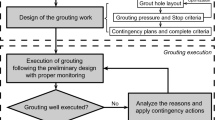Abstract
Permeation grouting is used to improve rock conditions under dams and foundations. During recent decades, there has been a substantial increase of understanding of the mechanism behind grout spread in fractured rock. It is the penetrability of the grout mix and the spread in the joints which will be the governing factors for the quality of the grout curtain. The flow properties and the pressure will give the required time to achieve the quality. The empirical based refusal and completion criteria of today can be replaced by a more engineering based grouting process. An active control method has been developed in order to govern the grout spread during the grouting operation based on the new theory of spreading of grout. The concept is called the “real time grouting control method”. The concept and the latest finding of the mechanism of spreading of the grout in the fractures of the rock mass are presented in the paper. The application of the method on two dam projects is also presented.



















Similar content being viewed by others
References
Axelsson M (2009) Prevention of erosion of fresh grout in hard rock. Doctoral thesis, Division of GEO Engineering, Chalmers University of Technology, Göteborg, Sweden
Barker JA (1988) A generalized radial flow model for hydraulic tests in fractured rock. Water Resour Res 24(10):1796–1804
Beauheim R, Roberts R, Avis J (2004) Well testing in fractured media: flow dimensions and diagnostic plots. J Hydraul Res 42:69–76
Brantberger M, Stille H, Eriksson M (2000) Controlling the grout spread in tunnel grouting—analyses and developments of the GIN-method. Tunn Undergr Space Technol 15(4):343–352
Cornet F, Li L, Hulin J-P, Ippolito I, Kurowski P (2003) The hydromechanical behaviour of a fracture: an in situ experimental study. Int J Rock Mech Min Sci 40:1257–1270
Draganovic A (2009) Bleeding and filtration of cement-based grout. Doctoral thesis, Division of Soil and Rock Mechanics, Royal Institute of Technology (KTH), Stockholm, Sweden
Draganovic A, Stille H (2011) Filtration and penetrability of cement based grout: study performed with a slot. Tunn Undergr Space Technol 26:548–559
Eklund D, Stille H (2008) Penetrability due to filtration tendency of cement-based grout. Tunn Undergr Space Technol 23:390–397
Eriksson M (2002) Prediction of grout spread and sealing effect—a probabilistic approach. Doctoral thesis, Division of Soil and Rock mechanics, Royal Institute of Technology, Stockholm, Sweden
Eriksson M, Stille H (2003) A method for measuring and evaluating the penetrability of grouts. In: International conference of grouting and ground treatment, New Orleans. Geotechnical special publication no. 120, ASCE, pp 1326–1337
Eriksson M, Stille H, Andersson J (2000) Numerical calculations for prediction of grout spread with account for filtration and varying aperture. Tunn Undergr Space Technol 15(4):353–364
Ewert FK (1985) Rock grouting with emphasis on dam sites. Springer, Berlin
Fransson Å (2001) Characterisation of fractured rock for grouting using hydrogeological methods. Doctoral thesis, Department of Geology, Chalmers University of Technology, Göteborg, Sweden
Fransson Å (2002a) Characterization of a fractured rock mass for a grouting field test. Tunn Undergr Space Technol 6(4):331–339
Fransson Å (2002b) Non-parametric method for transmissivity distributions along boreholes. Ground Water 40(2):201–204
Fransson Å (2009) Selection of grouting material based on a fracture hydraulic aperture assessment. In: Nordic symposium of rock grouting, Finnish tunnelling association, Helsinki, Finland, pp 55–61
Fransson Å, Tsang C-F, Rutqvist J, Gustafson G (2007) A new parameter to assess hydromechanical effects in single-hole hydraulic testing and grouting. Int J Rock Mech Min Sci 44:1011–1021
Funehag J, Fransson Å (2006) Sealing narrow fractures with a Newtonian fluid: model prediction for grouting verified by field study. Tunn Undergr Space Technol 21(5):492–498
Gothäll R, Stille H (2008) Fracture dilation during grouting. Tunn Undergr Space Technol 24:126–135
Gustafson G, Fransson Å (2000) The use of transmissivity data from probe holes for predicting tunnel grouting: analyses of data from the access tunnel to the Äspö hard rock laboratory. Tunn Undergr Space Technol 15(4):365–368
Gustafson G, Stille H (1996) Prediction of groutability from grout properties and hydrogeological data. Tunn Undergr Space Technol 11(3):325–332
Gustafson G, Stille H (2005) Stop criteria for cement grouting. Felsbau 23:62–68
Gustafson G, Fransson Å, Butron C, Hernqvist L (2009) Effective aperture for grout penetration. In: Nordic symposium of rock grouting, Finnish tunnelling association, Helsinki, Finland
Gustafson G, Hernqvist L, Fransson Å, Funehag J (2010) The use of proxy parameters in pre-investigation, design and construction of tunnels with application to grouting. In: Proceedings of the rock mechanics in the Nordic countries 2010, Kongsberg, Norway
Håkansson U (1993) Rheology of fresh cement-based grouts. Doctoral thesis, Division of Soil and Rock Mechanics, Royal Institute of Technology, Stockholm, Sweden
Hässler L (1991) Grouting of rock—simulation and classification. Doctoral thesis, Division of Soil and Rock Mechanics, Royal Institute of Technology, Stockholm, Sweden
Hässler L, Stille H, Håkansson U (1988) Simulation of grouting in jointed rock. In: Proceedings of the 6th international congress on rock mechanics, Montreal, vol 2, pp 943–946
Hernqvist L, Fransson Å, Gustafson G, Emmelin A, Eriksson M, Stille H (2009) Analyses of the grouting results for a section of the APSE tunnel at Äspö hard rock laboratory. Int J Rock Mech Min Sci 46:439–449
Houlsby AC (1990) Construction and design of cement grouting. Wiley, USA
Kobayashi S, Stille H, Gustafson G, Stille B (2008) Real time grouting control method: development and application using Äspö HRL data. R-08-133, Swedish Nuclear Fuel and Waste Management Company, Stockholm, Sweden
Lombardi G (1985) The role of cohesion in cement grouting of rock. In: 15th ICOLD congress, Lausanne, vol III, pp 235–261
Lombardi G, Deere D (1993) Grouting design and control using the GIN principle. Water Power Dam Constr 45(6):15–22
Moye DG (1967) Diamond drilling for foundation exploration. Civ Eng Trans Inst Eng Aust 45(17):95–100
Palmström A, Stille H (2010) Rock engineering. Thomas Telford, London, Great Britain
Rafi JY (2010) Applying “real time grouting control method” in sedimentary rock with gotvand dam data. Master of Science thesis, Division of Soil and Rock Mechanics, Royal Institute of Technology, Stockholm, Sweden
Rombough V, Bonin G, Shuttle DA (2006) Penetrability control of GIN mixes during fractured rock grouting. In: Proceedings of the sea-to-sky geotechnique—59th Canadian geotechnical society, 1–4 October, pp 528–535
Shuttle D, Rombough V, Bonin G (2007) GIN distilled. Geotech News. September 3–6, http://www.groutline.com
Snow DT (1970) The frequency and aperture of fractures in rock. Int J Rock Mech Min Sci 7:23–40
Stille B, Stille H, Gustafson G, Kobayashi S (2009) Experience with the real time grouting control method. Geomech Tunn 2(5):447–459. doi:10.1002/geot.2009.00036
Warner J (2004) Practical handbook of grouting—soil, rock and structures. Wiley, New Jersey, USA
Weaver K (1991) Dam foundation grouting. ASCE, New York, USA
Zimmermann RW, Bodvarsson GS (1996) Hydraulic conductivity of rock fractures. Transp Porous Media 23:1–30
Author information
Authors and Affiliations
Corresponding author
Rights and permissions
About this article
Cite this article
Stille, H., Gustafson, G. & Hassler, L. Application of New Theories and Technology for Grouting of Dams and Foundations on Rock. Geotech Geol Eng 30, 603–624 (2012). https://doi.org/10.1007/s10706-012-9512-7
Received:
Accepted:
Published:
Issue Date:
DOI: https://doi.org/10.1007/s10706-012-9512-7




